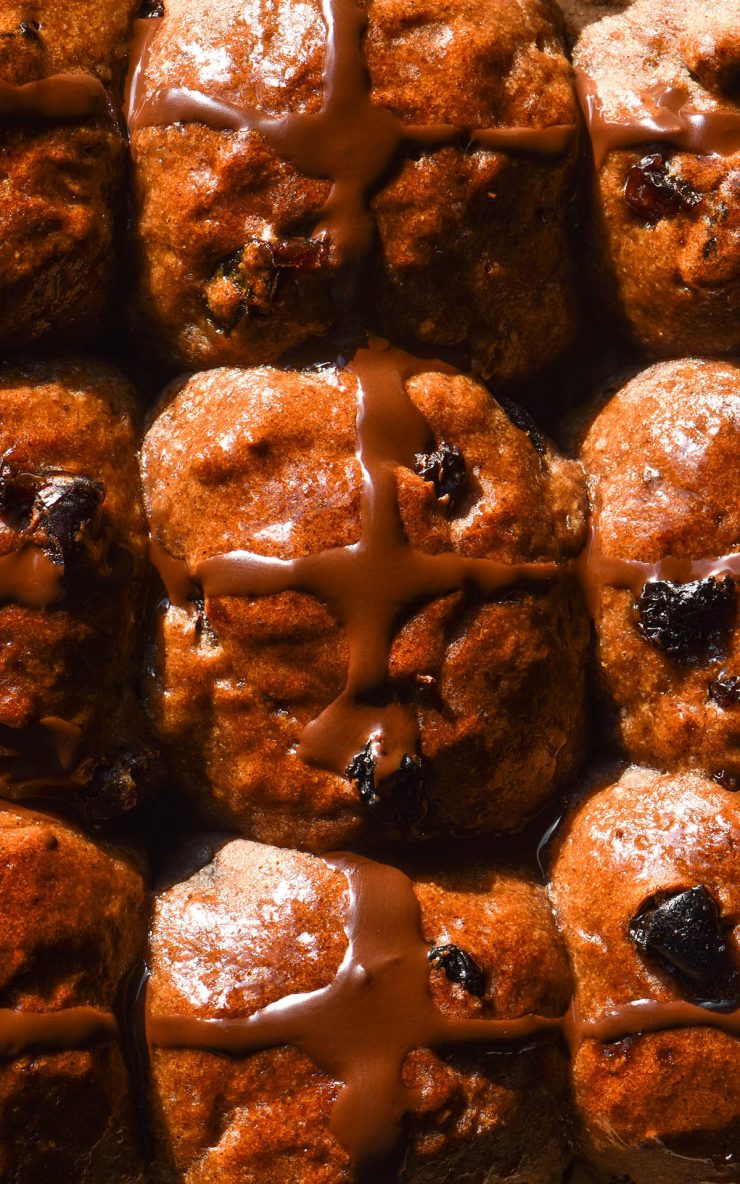
It’s coming up to HCB (hot cross bun) season and I have a number of recipes already on my site. What I didn’t previously have, however, was a recipe for gluten free hot cross buns without yeast. Given the success of my gluten free cinnamon rolls without yeast, I figured this recipe had to be next on my agenda.
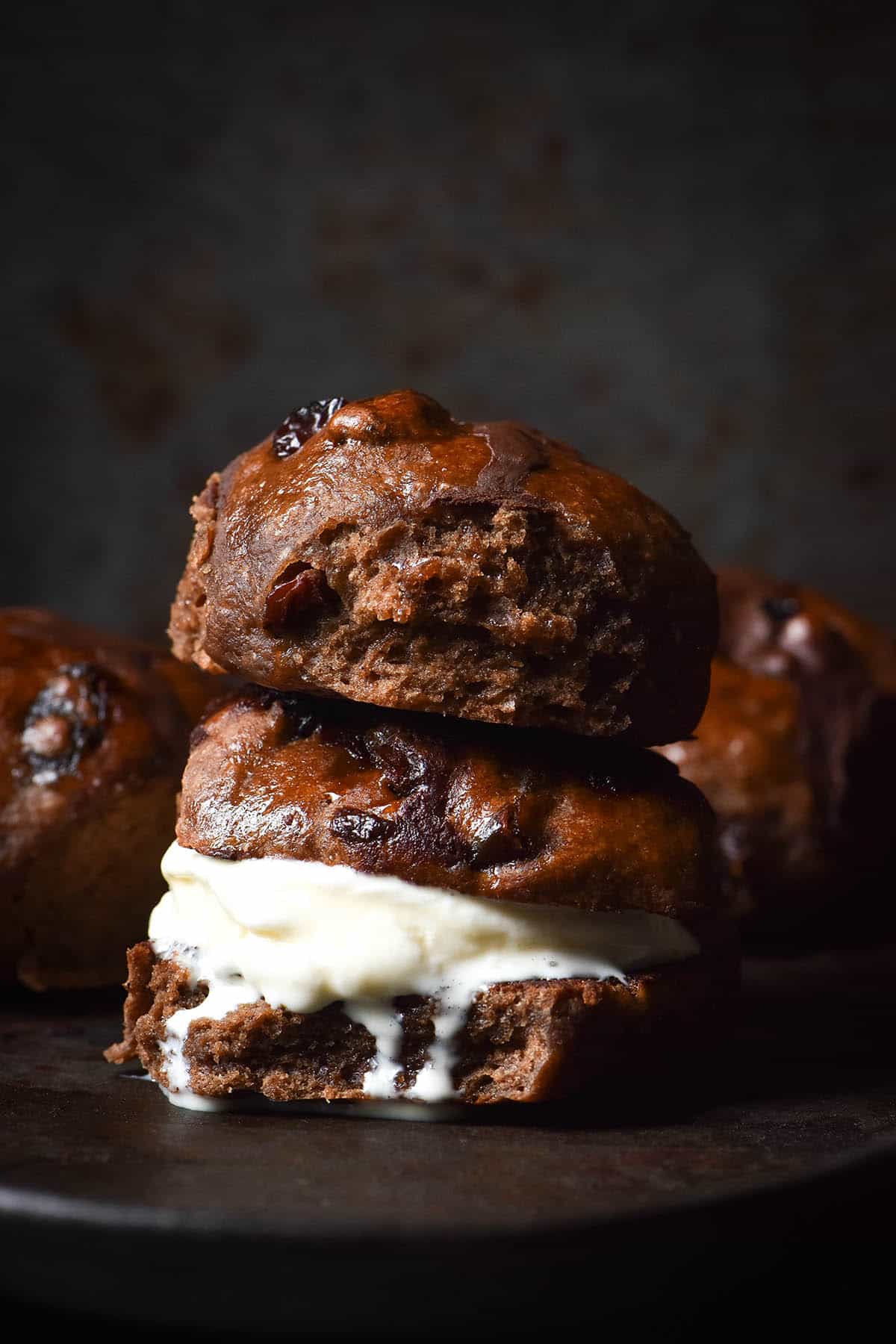
Gluten free hot cross buns without yeast
These hot cross buns are gluten free, yeast free, egg free, xanthan gum free and nut free. They can be made with traditional yoghurt or a plant based alternative, so they are easily dairy free/vegan.
The buns are made from a single flour – buckwheat flour – which makes them starchy flour free, rice free and corn free with the right baking powder.
These hot cross buns are easily made low FODMAP with a few simple ingredient tweaks that we will discuss below.
They are simple and delicious food intolerance friendly hot cross buns that everyone will love. The best part? There’s no waiting for the dough to proof. Simply mix (by hand, no equipment needed) and bake!
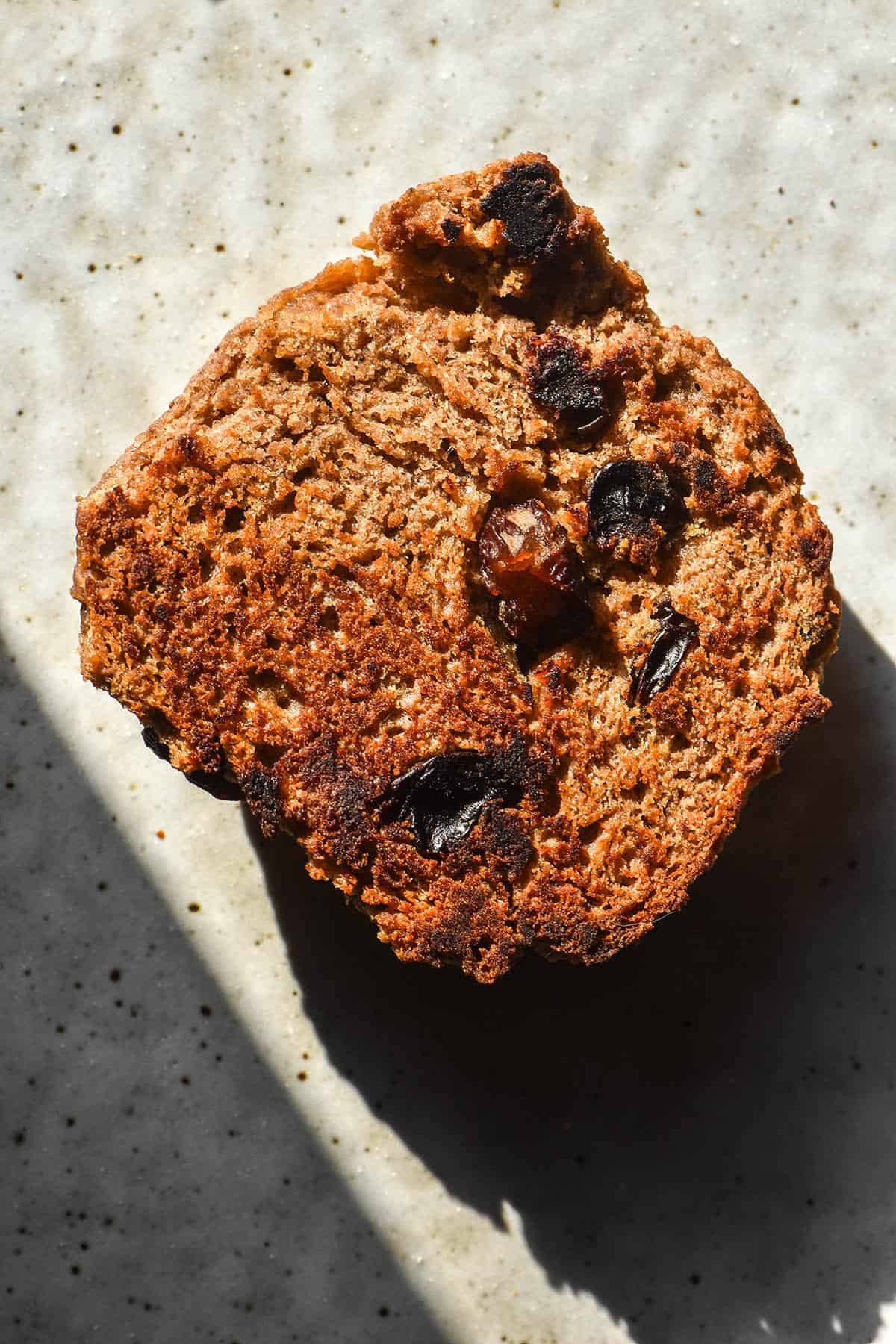
All my gluten free hot cross bun recipes (all without xanthan gum)
- Gluten free sourdough hot cross buns
- Gluten free hot cross buns that are vegan, starch free
- Single serve gluten free microwave hot cross bun
- Gluten free hot cross buns with starch (slightly fluffier and less wholegrain than the starch free version)
- Gluten free vegan hot cross bun loaf
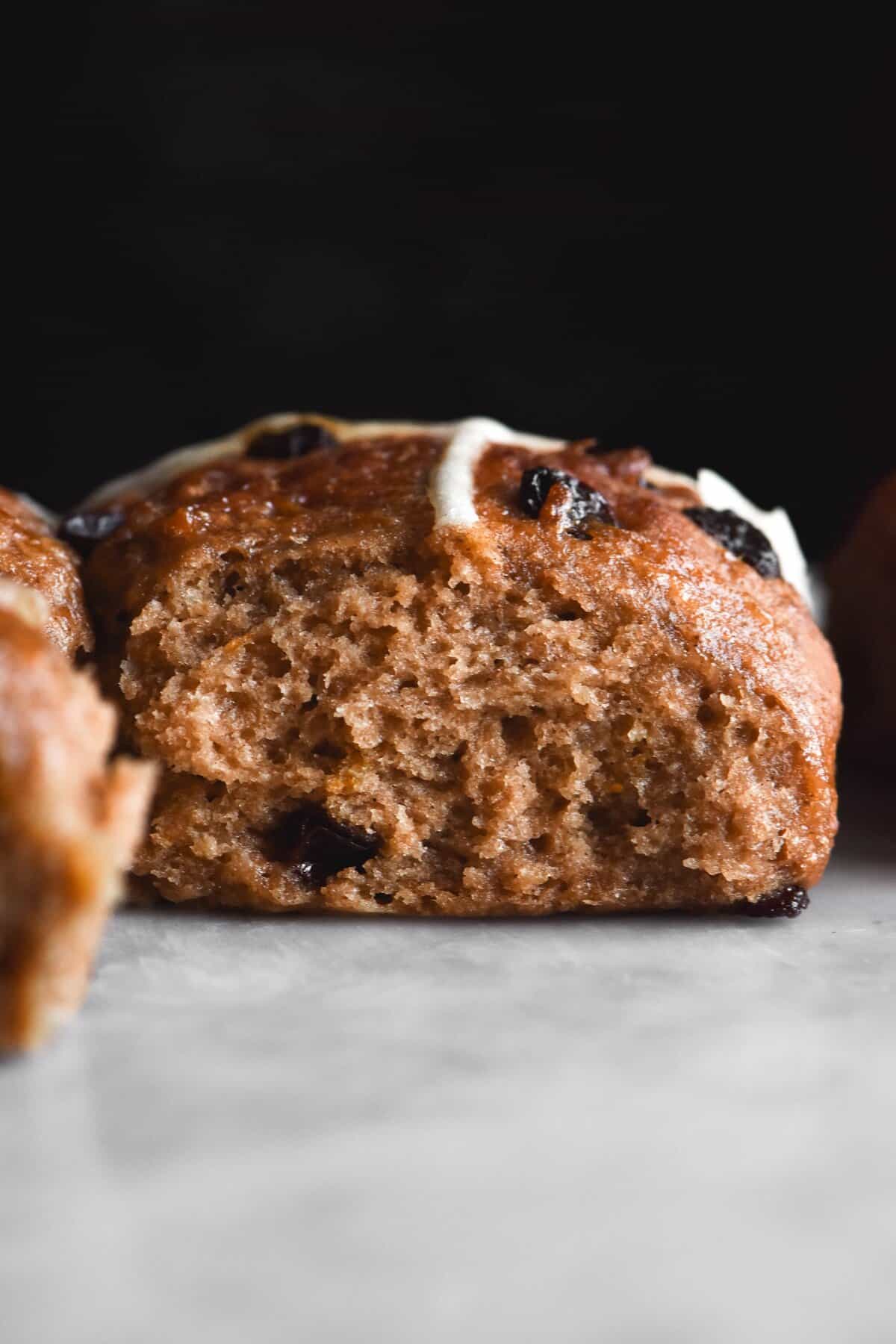
FODMAP notes
These FODMAP thresholds were last updated in mid June 2025. They will be periodically reviewed and updated to ensure they remain accurate.
Making these hot cross buns low FODMAP requires two simple tweaks. First, use a low FODMAP yoghurt. If you’re using regular yoghurt, be sure to choose a lactose free option if you have issues with lactose. If you’re making vegan buns, use a low FODMAP plant based yoghurt.
When I developed this recipe, raisins were lower FODMAP than sultanas. That appears to have changed, so we will discuss quickly below.
Raisins are low FODMAP in 4g serves per person. In 5g serves, they contain moderate amounts of fructose.
Sultanas are low FODMAP in 7g per person. In 9g serves, they contain moderate fructose and fructan. Divided between 8-9 buns, you can use 32-36g raisins in the dough, or 56-63g sultanas.
Regular dates are Low FODMAP in 30g serves, which is a more generous serve than both raisins and sultanas. Chopped dates are a good option if you want to use extra dried fruit.
Fruit peel or mixed peel is low FODMAP in up to 98g serves, after which it contains moderate amounts of fructans. This relatively generous serve makes it a good fruit option for a low FODMAP bun.
If you’d like to make fruit hot cross buns, I recommend using a combination of mostly mixed peel and a small quantity of raisins, sultanas or chopped dates.
Another option is to use chocolate chips in your buns. Dark chocolate is the lowest FODMAP option. It is low FODMAP in 30g serves and moderate for lactose in 80g serves. They also have an entry for 85% dark chocolate (20g) but no upper thresholds are listed.
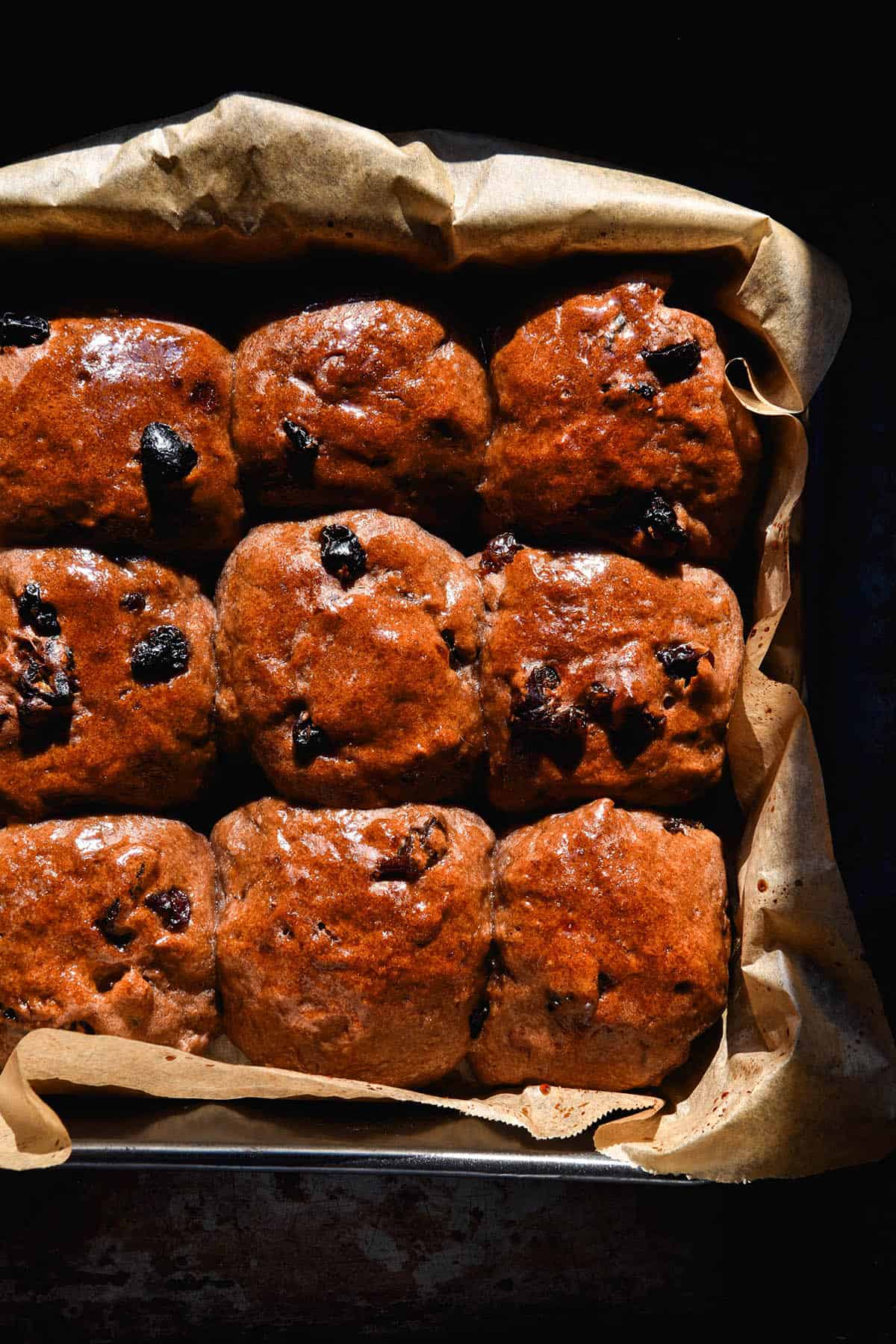
Substitution options for your gluten free hot cross buns without yeast
The only substitutions I have tested are using plant based alternatives to dairy in the dough and switching up the add ins.
- I haven’t tested any alternate sugars and I don’t plan to.
- I currently have no flour substitution suggestions. Because I don’t have access to dark buckwheat flour here in Australia, I have not tested this recipe with dark buckwheat flour.
- Psyllium husk powder is what I use in all my recipes these days. I buy the flakes and grind them to a powder myself in a spice grinder. I find that store bought powder has a purple grey hue once baked. There is no substitution for the powder in this recipe.
Hydration notes
As always, hydration is dependent on so many factors. Every bag of flour will have a different absorbency. On top of that, there will be differences betweens brands, countries, levels of humidity, etc. You need to have your wits about you and use your intuition (with all baking, gluten free or not).
I find this dough performs best if it is really quite sticky. With wet hands, you should be able to handle it with relative ease, but the dough should be wet and stick to your hands if they are dry. Each ball should hold its shape when you roll it (with wet hands) into a ball, but it should be a little tricky. After all, these are egg free, gluten free, yeast free hot cross buns. Something has to give 🙂
If your dough looks very dry, add more liquid! If it’s liquid, add more flour! Every batch of dough is different and its up to you to determine whether your dough is as described in the recipe.
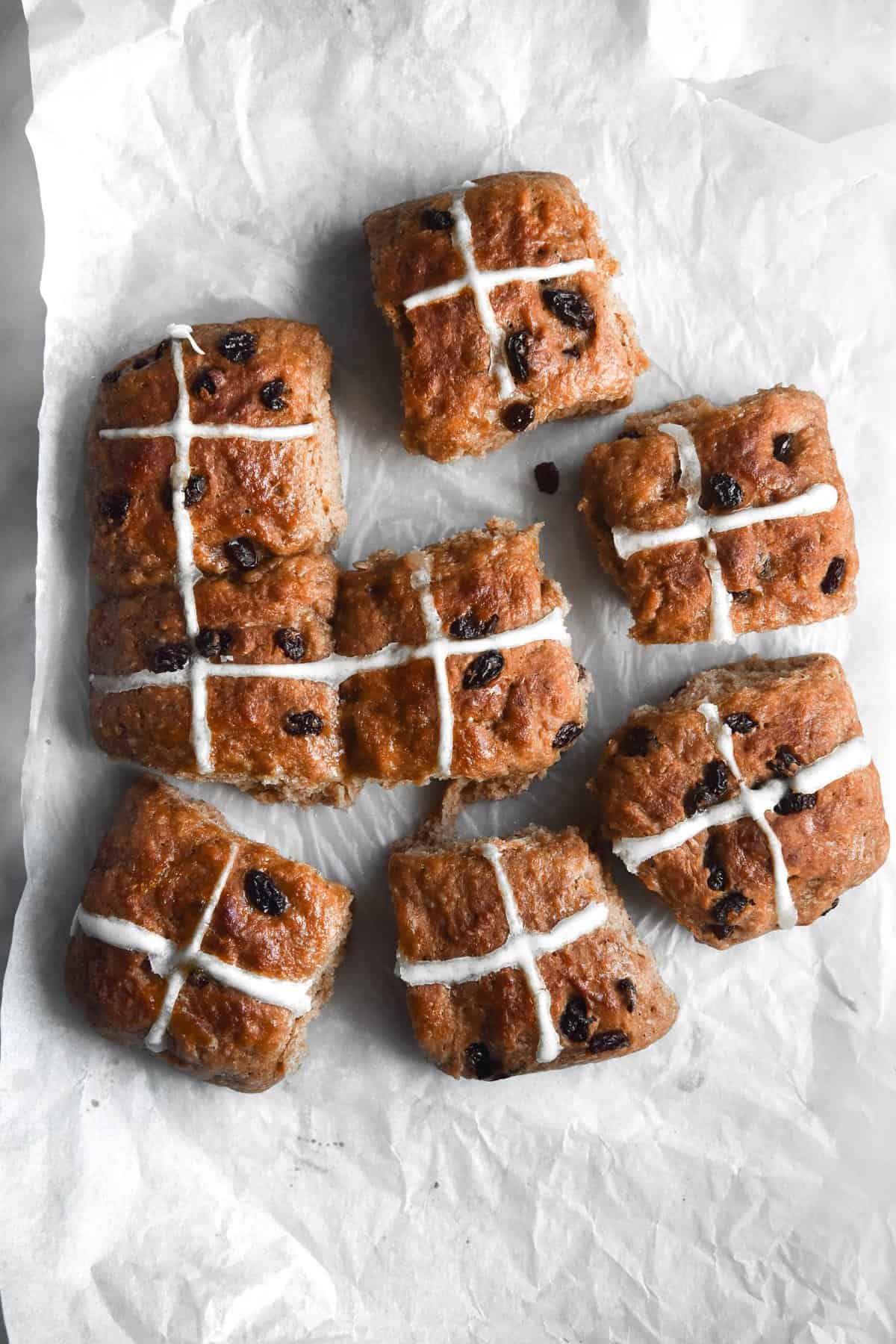
Tips for these gluten free hot cross buns without yeast
- I find that a sticky wet dough that is just a little too sticky to handle makes for the best buns here. A drier dough will result in a dry hot cross bun.
- Thoroughly smoothing the tops of your buns with wet hands will ensure they come out of the oven with smooth, normal looking tops.
- If your buns come out looking very craggy, one of two things happened. Either your dough wasn’t wet enough to begin with or you didn’t take the time to shape the buns prior to baking.
- Anecdotally, I found that buns with vegan yoghurt looked smoother and less craggy. However, I also found the coconut yoghurt seemed to mute the spices a bit. I’d recommend adding more spice to the vegan version if you like them spicy.
- Read the above notes on hydration before you start. There is no one right answer for how much water to add here. Your flour might be more or less thirsty than mine was.
- As discussed above, I grind my own psyllium husk powder in a Breville spice grinder. I find home ground psyllium husk is less likely to clump together when you first add it to liquid. It is also far less likely to turn your baked goods purple.
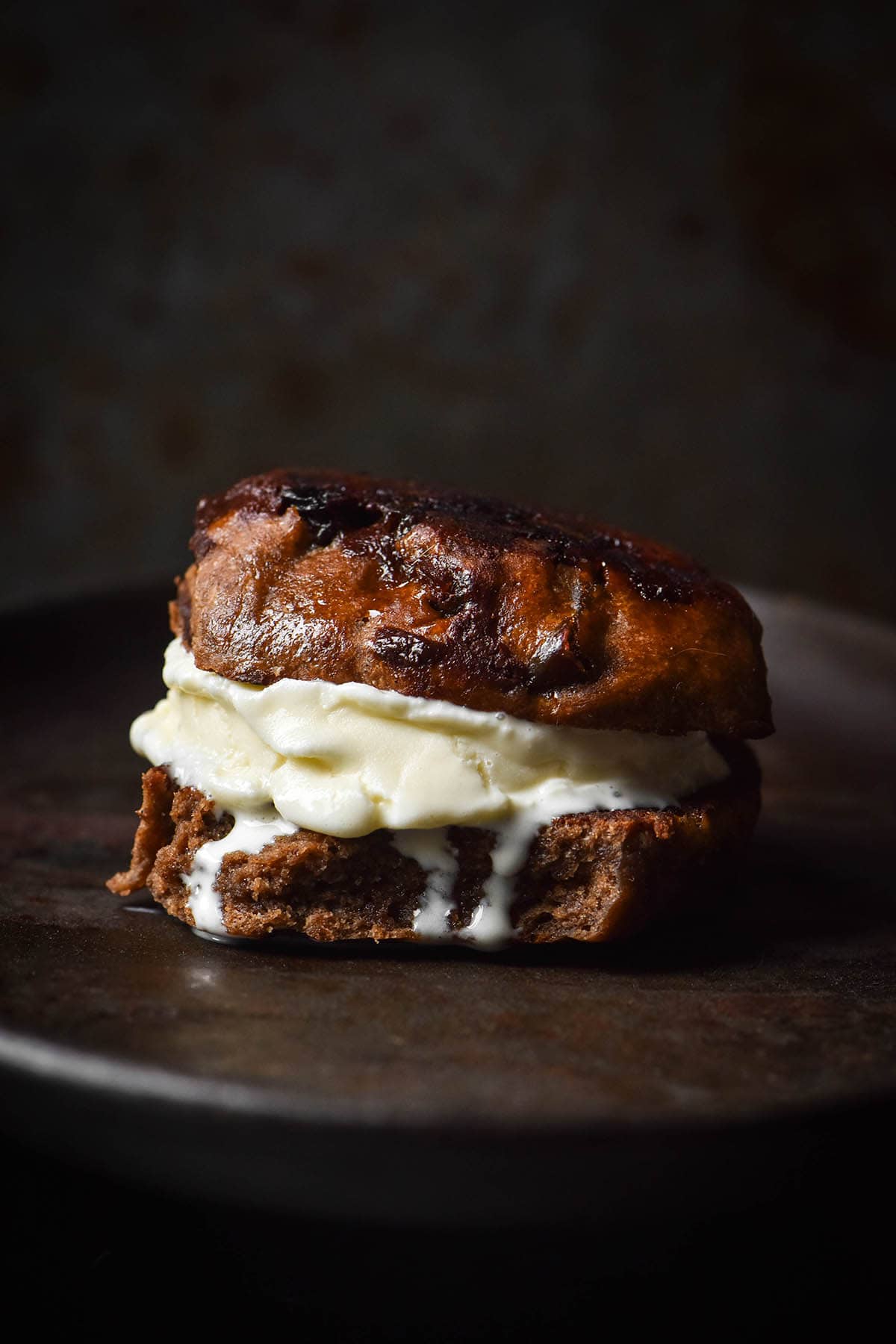
More gluten free baking recipes
- Gluten free vegan cinnamon rolls without yeast
- Easiest ever gluten free chocolate cake
- 10 gluten free, xanthan gum free and egg free mug cake recipes in my mug cake e-book
- Gluten free vegan brownie cookies
- Gluten free tahini cookies (3 ingredient!)
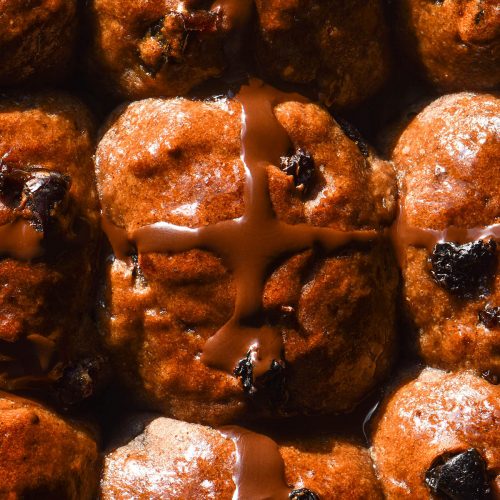
Gluten free hot cross buns without yeast
Ingredients
For the binder:
- 250ml (1 cup)* boiling water see notes
- 200 g plain unflavoured thick yoghurt, regular or plant based
- 20 g psyllium husk powder
For the dough:
- 300 g light buckwheat flour
- 150 g light brown sugar
- 1 Australian tablespoon cinnamon (4 US, NZ, British and Canadian teaspoons)
- 1 teaspoon nutmeg (use less if grating it fresh)
- 1 teaspoon allspice (optional, for those who like their buns extra spicy)
- orange zest, to your tastes (optional)
- 5g (1 teaspoon) gluten free baking powder
- 2.5g (1/4 teaspoon) baking soda (for browning)
- 125ml (1/2 cup)* vegetable oil or neutral oil
- 50-75 g sultanas or dark chocolate chips (see FODMAP notes in body of post if you need these to be low FODMAP)
For the crosses (optional):
- 1 Australian tablespoon glutinous rice flour or starch of choice (4 US, NZ, British and Canadian teaspoons)
- 2 teaspoons white rice flour
- 1 teaspoon plain oil I used vegetable oil
- Water to form a smooth but cohesive paste (2-3 teaspoons as a rough guide)
- Maple syrup or citrus jam to brush the buns after baking
Instructions
To make the dough:
- Preheat the oven to 180C/356F and line a 24 x 24cm (9.5 inch x 9.5 inch) square brownie/cake tin with baking paper, leaving some overhanging to act as handles later.
- Combine the boiling water and yoghurt in a medium mixing bowl. Add the psyllium husk powder and whisk vigorously until there are no lumps remaining. Set aside for 15 minutes to form a gel.
- In a large mixing bowl, whisk together the remaining ingredients for the buns, except for the oil and any mix-ins you are using.
- Once the gel is ready, pour it into the dry ingredient bowl along with the oil. Use a spoon to combine most of the way, then get your hands in and squelch the dough through your fingers until all the flour has been picked off up the bottom of the bowl.
- Continue until the dough is a uniform light brown with no light patches from the yoghurt and no lumps of flour. This will take about 5 minutes but is necessary for an edible bun, so keep going until you get a uniform consistency.
- I find this dough works best when it can hold its own shape but is too sticky to roll or hold in a dry hand. If yours is drier than this, adjust as necessary. If yours is wetter, I'd suggest leaving it. Your buns might spread into one giant bun, but they will be nice and moist.
- Add the mix-ins, if you are using them. Use your hands to distribute them through the dough.
- Thoroughly wet your hands with water, then divide the dough into 9 balls. I do this on the bench so I can eyeball that they are roughly the same size.
- Thoroughly wet your hands again, then roll each piece of dough into a ball with a smooth top. The smoother the top is before baking, the nicer the bun will look after baking.
- If you only have a baking dish that is larger than the one specified, use smaller dishes to tuck the buns in tightly. They will spread if left to their own devices.
To make and pipe the crosses (optional):
- Combine all the ingredients in a small bowl and whisk to combine. Add water until you have a smooth but pipe-able consistency. If you overshoot it, add equal parts of each flour until you are back to a good consistency.
- Use a piping bag or small sandwich bag with the corner cut off to pipe crosses onto the buns.
To bake:
- Place the buns in the oven for 25-30 minutes or until golden brown and firm to the touch.
- As soon as the buns come out of the oven, brush them with maple syrup or marmalade (ideally strained) so they have a glossy and delicious finish. Allow them to cool for 15-20 minutes at least before eating.
- These buns are best on the day of baking. However, they can be toasted and smeared with butter for a great result thereafter. You can also microwave or steam heat them to restore them to their former glory.
Notes
- Read the tips section in the body of the post to get the most out of this recipe. I don’t write it for fun, I promise.
- I haven’t tried this recipe in the stand mixer, but I think it would work nicely. Where possible, I try to make my recipes as inclusive as they can be – not everyone has a stand mixer.
- Personally, I found that the coconut yoghurt/vegan version tasted less spicy than the dairy version. This might just be me, but I’d suggest adding a little extra spice to the vegan version if you like well spiced buns.
- I have only tried light buckwheat flour in this recipe because it’s all I have access to in Australia.
- See the body of the post for FODMAP notes and hydration notes.
- I don’t often pipe the crosses these days, but I have added the option in case you’d like to.
- If you only have a baking dish that is larger than the one specified, use smaller dishes to tuck the buns in. They will spread if left to their own devices.

I made these gf vegan hot cross buns without yeast for Easter last weekend and the result was phenomenal really… Fairly easy to work with, and success for the first try! It’s so hard to find great Gf recipes that are also vegan and without gums etc… Thank you so much, I’ll be trying out your other recipes now ????????
So glad to hear you enjoyed the recipe Adri! I hope you had a lovely Easter 🙂